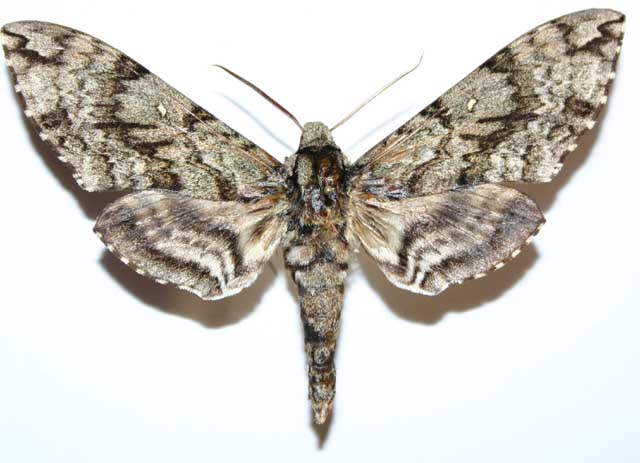CATE: "Head and thorax pale olive, pro- and mesonotum with a black lateral stripe; metanotum with a black and white lateral tuft.
Abdomen marked with black transverse lateral bands that separate the whitish grey side patches.
"Both wings with uppersides greyish creamy buff or grey, shaded with brown, crossed by black lines and bands. Forewing upperside with traces of a basal and a
subbasal line at costal margin; three antemedian lines curving costad anteriorly, the most proximal weakly marked; 3 parallel, regularly crenate discal lines,
the space between the first 2 blackish; an interrupted postdiscal line is almost evenly curved from costa to vein CuA2; submarginal line indicated by
halfmoons on veins M3 and CuA2, the space between the anterior halfmoon and the postdiscal line blackish, as in Manduca jasminearum and Manduca florestan;
an oblique apical line joins the postdiscal line between veins Rs4 and M1; 2 black discal streaks between veins M3 and CuA2 extend basad into the broad pale
discal space; discal spot smallish, white with a thin brown border; fringe with creamy white spots.
"Underside of both wings with similar ground colour to upperside. Forewing underside more shaded with brown than upperside; the proximal discal line indistinct,
the others crenate.
"Hindwing upperside with a large, but ill-defined black basal patch; 2 parallel discal bands, the proximal the broader and of even width, situated just distal to
the discal cell; the distal crenate, consisting of contiguous halfmoons; a broad marginal band, distally shaded with grey scaling, a black dash running through
the grey marginal scaling at the apex of the wings.
"Hindwing underside with a discal band just distal of the discal cell, curving basad at inner margin, subdivided into 2 in anterior half; distally a parallel,
crenate 3rd band, followed by a paler brown, ill-defined submarginal band."

